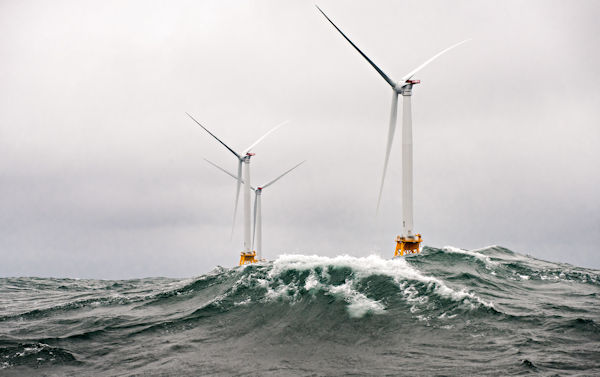SEJournal Online is the digital news magazine of the Society of Environmental Journalists. Learn more about SEJournal Online, including submission, subscription and advertising information.
 |
 |
| Turbines at the Block Island Wind Farm, the first U.S. offshore wind farm. Photo: National Renewable Energy Lab, Flickr Creative Commons. Click to enlarge. |
TipSheet: Conflict Over Biden’s Offshore Wind Drive To Generate News in 2022 and Beyond
EDITOR'S NOTE: This story is one in a series of special reports from SEJournal that looks ahead to key issues in the coming year. Visit the full “2022 Journalists’ Guide to Energy & Environment” special report for more.
By Joseph A. Davis
The Biden administration is determined to foster offshore wind energy — its lack of greenhouse gas emissions makes it attractive as a climate solution. But the process of getting offshore wind projects built can generate conflict, and many proposals have already encountered obstacles.
One instructive example is the saga of Cape Wind (may require subscription), a project proposed in Nantucket Sound off the coast of Massachusetts. After a 16-year legal, regulatory and political struggle (plus millions of dollars in sunk costs), the developer finally gave up in 2017.
Perhaps it was too close to wealthy and powerful coastal property owners, but similar problems can be expected elsewhere.
Executive action, meet state jurisdiction
The country currently has only two small offshore wind farms in operation, far fewer than European nations and China have. But the Biden administration’s hopes for legislative action on climate (of which wind energy is a part) are currently being frustrated in the Senate.
One possible advantage of offshore wind is that it can — theoretically — be expanded by the use of existing executive powers. The federal government can, for instance, lease offshore tracts for wind turbines just as it leases oil drilling, under the Outer Continental Shelf Lands Act of 1953.
But it’s not simple.
The main agency that leases tracts for offshore energy is the Bureau of Ocean Energy Management, or BOEM, a subdivision of the Interior Department. BOEM can lease “lands” up to 200 miles from the coastline.
Because power lines must cross state waters,
and ports onshore must support an offshore
wind operation, states must inevitably be involved.
States, however, have jurisdiction over waters three to nine miles out. Because power lines must cross state waters, and ports onshore must support an offshore wind operation, states must inevitably be involved.
There are more hoops to jump through before Outer Continental Shelf lands can be leased — especially the National Environmental Policy Act, which normally requires an environmental impact statement before a major federal action. The Trump administration curtailed this requirement, but the Biden administration mostly restored it.
Most of U.S. coastline on the table
The Biden administration made a big announcement Jan. 12 when it announced a “record-breaking” auction to be held in February of some 488,000 acres off the coasts of New York and New Jersey. Officials said BOEM could hold up to six additional auctions by 2025.
The New York-New Jersey auction was not the first offshore wind project for the administration. In November, it approved the South Fork Wind Project off Rhode Island and in May approved Vineyard Wind off of Martha’s Vineyard.
Some states are actively seeking offshore wind projects, among them New York, Massachusetts, New Jersey and North Carolina. The administration is looking at other sites along the Atlantic, Gulf and Pacific coasts. Pretty much the entire U.S. coastline (may require subscription) is on the table.
Tracking steps for project approvals
The euphoria for now may eclipse the kind of opposition that comes out of the woodwork on offshore wind projects.
And it’s not just wealthy property owners. Many coastal towns rely on thriving tourist industries, and some worry that turbines could mar the ocean view. Fishing operators likewise fear that turbines could have a negative effect on their work. Environmental groups sometimes worry that turbines will harm sensitive ocean creatures like whales.
One thing that seems to matter: how far offshore the turbines are.
Arguably, the Biden administration has accomplished much in shepherding so many offshore wind projects so far along as it has. Environmental journalists, however, may be well advised to stay mindful of how many roadblocks can be raised at the many stages in state, federal and local review of projects — and the lawsuits that can pop up at any one of them.
If you want to track the steps in project approval (or disapproval), you can get some idea of those milestones in this report on the regulatory roadmap, a discussion of the permitting process, in this New York State page on understanding federal and state permitting and approvals and in this case study on Cape Wind.
[Editor’s Note: Also check out this Reporter’s Toolbox on tracking the spread of turbines (both on- and offshore), plus an overview TipSheet of the renewable energy scene from our 2021 Journalists’ Guide.]
Joseph A. Davis is a freelance writer/editor in Washington, D.C. who has been writing about the environment since 1976. He writes SEJournal Online's TipSheet, Reporter's Toolbox and Issue Backgrounder, and curates SEJ's weekday news headlines service EJToday and @EJTodayNews. Davis also directs SEJ's Freedom of Information Project and writes the WatchDog opinion column.
* From the weekly news magazine SEJournal Online, Vol. 7, No. 3. Content from each new issue of SEJournal Online is available to the public via the SEJournal Online main page. Subscribe to the e-newsletter here. And see past issues of the SEJournal archived here.












 Advertisement
Advertisement 



